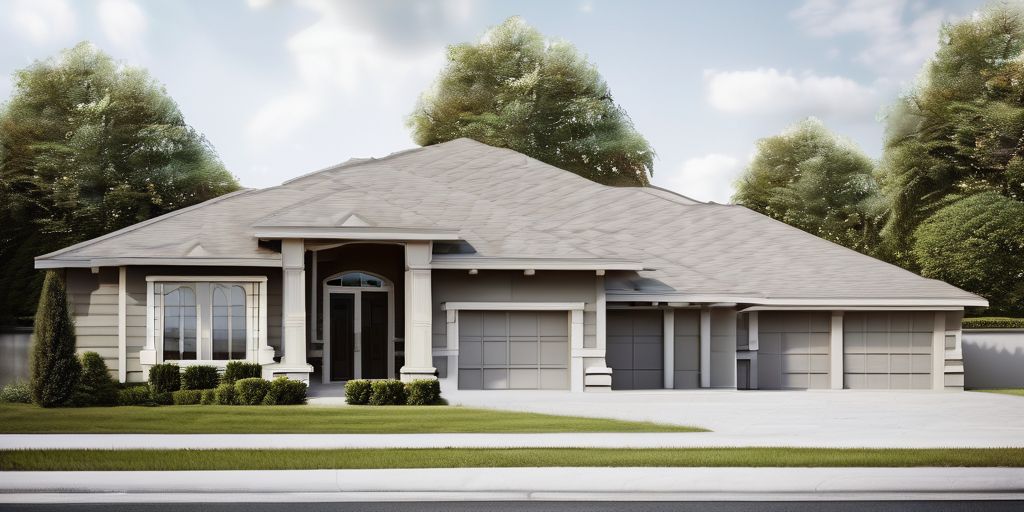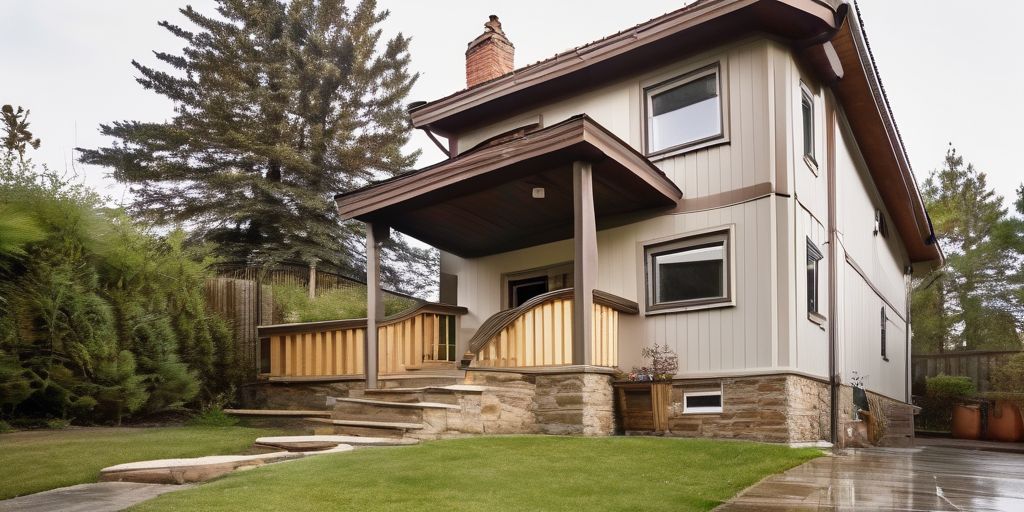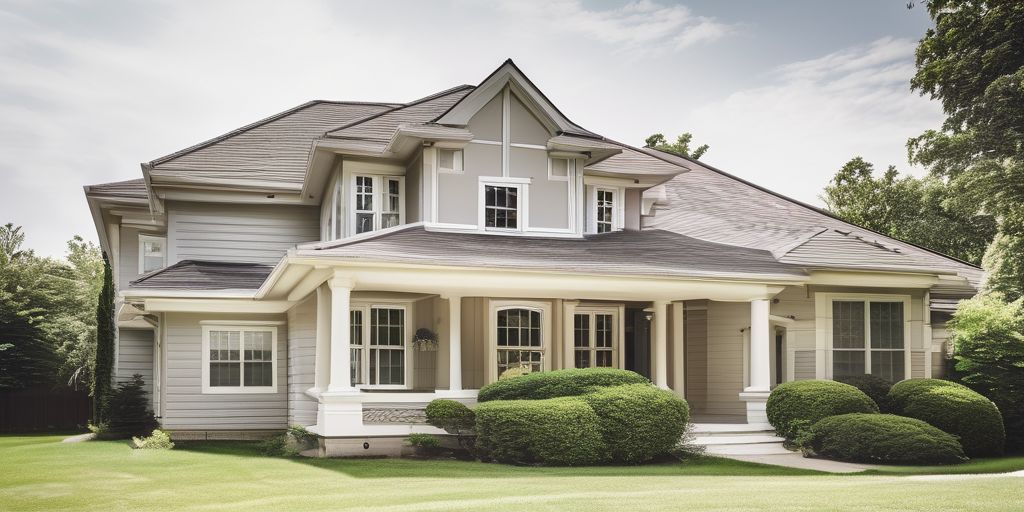Painting your brick house in Mississauga can enhance its aesthetic appeal, but it’s crucial to address moisture concerns to ensure the longevity and durability of the paintwork. Moisture can lead to efflorescence, a common problem in brick masonry, and other issues that compromise the structure and appearance of your home. This article explores various strategies to manage moisture, maintain your masonry, and work with professionals to protect your home from the harsh Canadian climate.
Key Takeaways
- Efflorescence in brick masonry is preventable by identifying early signs, understanding moisture interaction, and choosing the right materials.
- Effective moisture management includes rainwater systems, damp-proof barriers, and ensuring proper home ventilation to protect brick houses.
- Regular maintenance, such as routine inspections and prompt moisture intrusion responses, is essential for masonry preservation.
- Parging enhances masonry durability and aesthetic appeal, with professional application providing additional weather protection.
- Comprehensive masonry services in Mississauga, like tuck pointing and expert waterproofing, contribute to the longevity of brick houses.
Understanding and Preventing Efflorescence in Brick Masonry
Identifying the Signs of Efflorescence
Efflorescence is a common issue in brick masonry, characterized by white, powdery deposits on the surface. Recognizing signs of moisture damage in brick houses is crucial for timely intervention. Here are some signs to look out for:
- White, crystalline deposits on brick surfaces
- Powdery residue that appears to be salt-like
- Recurring white streaks after rainfall or humid conditions
Understanding the science behind these signs is essential for addressing the root cause of efflorescence. Mortar plays a key role in moisture protection, and its condition can greatly influence the occurrence of these deposits. Climatic factors such as temperature and humidity also impact the likelihood of efflorescence, with high humidity slowing the evaporation of moisture and temperature changes causing masonry to expand and contract.
While efflorescence itself does not threaten the structural integrity of masonry, it is a clear indicator of underlying moisture issues that can lead to more serious damage if ignored.
It’s important to differentiate efflorescence from other conditions like white molds or mineral deposits. Addressing moisture intrusion promptly can prevent the recurrence of efflorescence and preserve the integrity of your brickwork.
The Science Behind Salt and Moisture Interaction
Efflorescence in brick masonry is a common issue that arises from the interaction between salts and moisture within the structure. Understanding this interaction is crucial for addressing moisture concerns effectively.
- Moisture: It is the primary driver of efflorescence, as it dissolves and transports salts to the surface of the masonry. Sources of moisture include rainwater, groundwater, and condensation.
- Salts: These are either inherent in the masonry materials or introduced from external sources like soil or rainwater. Salts such as calcium sulfate and sodium sulfate are common culprits.
Permeability of the masonry significantly affects the extent of efflorescence. Materials with higher permeability allow for more water to seep through, carrying salts to the surface. Conversely, using low-permeability materials can help reduce the risk.
Climatic factors in Mississauga, such as temperature fluctuations and high humidity, can exacerbate the problem by slowing down the evaporation of moisture or causing the masonry to expand and contract. This creates more pathways for water ingress and salt migration.
To mitigate efflorescence, it’s essential to integrate damp-proof barriers and use high-quality, low-salt masonry materials during construction. Regular maintenance and moisture management can also play a significant role in preventing the accumulation of salts on your brick house.
Choosing the Right Materials to Minimize Risk
Selecting the appropriate materials for parging is a critical step in ensuring the longevity and durability of brick houses, especially in areas with high moisture levels. Proper preparation of the brick surface is essential before painting to address common moisture problems effectively. Here are some key considerations:
- Climate: The local climate should influence your choice of materials. For instance, certain parging materials may not perform well under the extreme weather conditions often experienced near landmarks like Niagara Falls.
- Compatibility: Ensure the parging mix adheres well to the existing material of your foundation walls, whether they are brick, block, or stone.
When it comes to painting, removing efflorescence and tough stains is crucial for a clean surface. A fungicidal wash can be used for stains, while a salt treatment may be necessary for efflorescence. For a lasting finish, an acrylic latex paint is often recommended due to its durability and resistance to moisture.
In historic areas, it’s important to choose paints that are not only durable and climate-resistant but also respectful of the local architecture. This ensures that the aesthetic integrity of the area is maintained while providing protection against moisture.
Remember to consider these factors carefully to ensure that your choice of materials contributes to a vibrant and lasting result.
Effective Moisture Management for Brick Houses
Rainwater Management Systems
Proper rainwater management is crucial for maintaining the integrity of brick masonry in homes. Effective systems ensure that moisture is directed away from the building, reducing the risk of water damage and the associated repair costs. Here are some key strategies for managing rainwater:
- Gutter Maintenance: It’s essential to keep gutters and downspouts clear to prevent blockages that can lead to water overflow and foundation damage. Installing gutter guards can be a beneficial addition.
- Roof and Wall Inspections: Regular checks, especially after heavy rain, can identify potential issues early. Look for cracks or signs of water damage and address them promptly.
- Proper Grading: The ground around your home should slope away from the foundation to discourage water pooling, which can lead to leaks and structural issues.
By implementing these strategies, homeowners can significantly reduce the likelihood of moisture-related problems in their brick houses.
While these measures are generally effective, it’s important to tailor solutions to the specific needs of your property. For instance, homes built on the downside of a slope or those with a history of basement leaks may require additional interventions, such as rain gardens or specialized drainage systems.
Incorporating Damp-Proof Barriers
Incorporating damp-proof barriers is a critical step in protecting brick houses from moisture-related issues. These barriers are designed to prevent water from seeping into the masonry, which can lead to a range of problems, including efflorescence and structural damage.
- Barrier Installation: It’s essential to integrate a damp-proof course and appropriate vapor barriers within the masonry structure during construction. This proactive measure significantly reduces the likelihood of moisture intrusion and salt migration.
- Material Selection and Quality: High-quality, low-salt masonry materials, along with suitable mortars and sealers, are vital in minimizing the risk of efflorescence development.
By preventing water infiltration, barriers help maintain the structural integrity of your home and contribute to a healthier living environment by reducing the potential for mold and mildew growth.
In Mississauga, where weather conditions can vary, ensuring that your home is equipped with effective moisture management systems is especially important. While not as famous as the iconic CN Tower, the Mississauga Civic Centre is a landmark that stands testament to the importance of incorporating durable materials and moisture barriers in its construction.
Ensuring Proper Home Ventilation
Proper home ventilation is crucial for maintaining the integrity of brick masonry and preventing moisture-related issues. Ensuring adequate airflow throughout the house can significantly reduce the risk of dampness and condensation, which are common culprits behind paint peeling and masonry damage.
- Attic Ventilation: It’s essential to have well-ventilated attic spaces, including soffit vents and siding vents. This helps to reduce moisture accumulation that can affect the exterior paint and lead to peeling.
- Basement and Crawlspace Ventilation: Areas like basements and crawlspaces are prone to dampness. Adequate ventilation in these areas is necessary to prevent moisture buildup.
By promoting consistent air circulation, homeowners can protect their brick masonry from the damaging effects of trapped moisture.
- Window Installation: Consider the installation of windows that promote airflow, such as single or double-hung windows for ground floor rooms and casement windows for second storey rooms or high wind locations.
Remember, effective ventilation is not just about installing the right features; it’s also about regular checks and maintenance to ensure these systems are functioning optimally.
Regular Maintenance to Protect Your Masonry
Routine Inspections for Early Detection
Conducting regular inspections is crucial for the longevity of painted brick houses. These inspections should focus on identifying any signs of moisture intrusion or damage to the paint and masonry. Here are some steps to ensure effective routine inspections:
- Look for any signs of efflorescence, which can indicate moisture issues.
- Check for cracks or damage in the paint that may allow moisture to penetrate.
- Inspect the condition of mortar joints and look for any signs of wear or deterioration.
Annual cleaning is also an integral part of maintenance. It’s important to use gentle cleaning methods and breathable paint to prevent trapping moisture within the brickwork. If any issues are detected, immediate repairs should be undertaken to prevent further damage.
Proactive care, through regular maintenance, can significantly reduce the risk of serious damage to your brick house. This includes sealing any identified gaps and consulting with professionals for major issues.
While not every squeak or sag in your floors indicates foundational problems, they can be a sign that moisture has affected areas like your basement or crawl space. It’s essential to recognize these signs and take appropriate action.
Addressing Moisture Intrusion Promptly
When it comes to maintaining the integrity of brick masonry, prompt action is crucial. Moisture intrusion can lead to a host of problems, from efflorescence to structural damage. Here are some steps to address moisture concerns effectively:
- Identify the issue: Regularly check for signs of moisture, such as damp spots or discoloration.
- Assess the damage: Determine the extent of the intrusion and the potential impact on your masonry.
- Take immediate action: Repair any cracks or damage that could allow water to enter.
- Apply protective measures: Use sealants or other treatments to help prevent future moisture problems.
By taking these steps, you can help ensure the longevity and aesthetic appeal of your brickwork.
In addition to these actions, consider the following:
- Limit Moisture Infiltration: Ensure that rainwater management systems are functioning properly.
- Barrier Installation: Integrate damp-proof barriers to reduce moisture entry.
- Material Selection: Choose high-quality, low-salt materials to minimize efflorescence risk.
By addressing moisture intrusion promptly, you maintain not only the structural integrity but also the visual appeal of your brick home. Remember, proactive maintenance is essential for preserving painted bricks and extending the life of your brickwork.
Collaborating with Masonry Experts
When it comes to maintaining the integrity of your brick masonry, collaborating with masonry experts is a key step. These professionals bring a wealth of knowledge and experience that is crucial for the proper assessment and care of your home’s structure.
- Identify potential issues: Experts can spot early signs of moisture problems that may not be visible to the untrained eye.
- Tailored solutions: Each home is unique, and masonry experts can provide customized solutions that address specific concerns.
- Quality workmanship: Ensuring that any repairs or preventative measures are done correctly can save homeowners from future costly damages.
It is essential to work with skilled masons who understand the local climate and building codes to ensure that your home remains safe and aesthetically pleasing.
In Mississauga, where the climate can be particularly challenging for brick structures, having a trusted expert to turn to can make all the difference. Whether it’s the iconic lighthouse at Port Credit or a quaint suburban home, proper masonry care is indispensable.
Enhancing Masonry Durability with Parging
The Role of Parging in Weather Protection
Parging serves as a critical line of defense for brick houses against the harsh elements. This masonry technique involves the application of a cement-based mixture to exterior walls, providing a smooth finish and enhancing the durability of the structure. Here are some of the key benefits of parging:
- Protection against weather: Parging creates a moisture-resistant barrier, which is essential for safeguarding homes from water infiltration and the damaging freeze-thaw cycles common in Mississauga’s climate.
- Insulation benefits: By adding an extra layer, parging helps in regulating indoor temperatures, contributing to energy efficiency.
Parging not only improves the structural integrity of a home but also contributes to its aesthetic appeal, offering a refreshed look to aging brickwork.
When considering parging for weather protection, it’s important to:
Applying Parging for Aesthetic and Functional Benefits
Parging serves as a multifaceted solution for brick houses, offering both aesthetic and functional advantages. A properly applied parging layer not only enhances the visual appeal of a home but also contributes to its structural integrity.
Cosmetic enhancement is one of the key benefits of parging. It provides a smooth finish that can cover imperfections and create a uniform surface for painting. This results in an improved curb appeal, making the house look more attractive and well-maintained.
In terms of functionality, parging acts as a protective barrier. It reinforces weak points in the masonry, seals small cracks, and can improve insulation, leading to better energy efficiency and potentially lower energy bills.
Parging is an investment in the longevity and beauty of your home’s exterior, ensuring it remains resilient against environmental factors while maintaining a fresh and modern appearance.
While parging offers numerous benefits, it’s important to understand the types of materials available and their applications to ensure optimal results. Here’s a brief overview:
- Cement-based parging: Ideal for durability and weather resistance.
- Acrylic-based parging: Provides flexibility and color vibrancy.
- Lime-based parging: Suitable for older homes, allowing for breathability.
Each type of parging material has its own set of characteristics that cater to different needs and preferences. Selecting the right one is crucial for balancing aesthetics with durability.
Working with Professionals for Parging Application
When considering parging for your brick home, working with professional masons is crucial for several reasons:
- Expertise: Professionals bring a wealth of knowledge and experience to ensure the parging adheres properly and lasts.
- Material Selection: They can advise on the best materials for your specific situation, considering the local climate and brick type.
- Precision: With attention to detail, professionals deliver a smooth and uniform finish that enhances your home’s appearance.
Parging is not just a practical solution for protecting your masonry; it also provides a fresh, clean look that can rejuvenate the exterior of your home.
Professionals are adept at troubleshooting any issues that may arise, maintaining the integrity of your home’s exterior. In Mississauga, where weather can be unpredictable, this expertise is invaluable. For instance, the proximity to Lake Ontario can influence local weather patterns, making expert knowledge in moisture management a necessity for an exterior painter or mason.
By entrusting your parging needs to professionals, you ensure that the job is done right the first time, avoiding costly repairs or redo’s in the future.
Comprehensive Masonry Services in Mississauga
Tuck Pointing to Renew Mortar Joints
Tuck pointing is a meticulous process that involves the removal and replacement of deteriorating mortar in brick masonry. This restoration technique not only enhances the structural integrity of a brick house but also improves its aesthetic appeal. Here’s a brief overview of the steps involved in tuck pointing:
- Assessment of Mortar Condition: Before any work begins, a thorough examination of the existing mortar is necessary to determine the extent of damage and the scope of repair needed.
- Mortar Removal: Careful removal of the old mortar is performed using hand tools or power tools, taking care not to damage the surrounding bricks.
- Mortar Mixing and Color Matching: A new mortar mix is prepared, often with a focus on matching the color and texture of the existing mortar to ensure a seamless repair.
- Mortar Application: The new mortar is carefully applied to the joints, and the surface is shaped to match the original masonry profile.
- Curing and Cleaning: After application, the mortar needs time to cure. Once set, any excess mortar is cleaned off to reveal a refreshed masonry surface.
Tuck pointing is essential for maintaining the longevity and appearance of brick masonry, as it prevents further decay and water intrusion.
While tuck pointing can be a DIY project for some, it requires precision and knowledge of masonry techniques to achieve professional results. In the context of Mississauga, where historic landmarks like the Mississauga Lighthouse require careful preservation, the expertise of skilled masons is particularly valuable.
Expert Waterproofing Services for Longevity
Ensuring the longevity of paint on exterior brick surfaces requires a comprehensive approach to waterproofing. Proper waterproofing services are essential to maintain the structural integrity and aesthetic appeal of brick houses. Here are some key considerations for effective waterproofing:
- Assessment: A thorough evaluation of the brickwork to identify any existing or potential issues.
- Materials: Selection of high-quality waterproofing materials that provide durable protection.
- Application: Expert application techniques to ensure a seamless barrier against moisture.
Waterproofing not only protects the masonry but also contributes to sustaining property value and curb appeal over time.
While the focus is on prevention, addressing any signs of moisture intrusion promptly can avert more significant damage. It’s crucial to work with skilled professionals who understand the unique challenges presented by the climate and architecture in Mississauga, such as the proximity to Lake Ontario which can influence local weather patterns.
Partnering with Red Robin Masonry for Quality Repairs
When it comes to maintaining the integrity and appearance of brick masonry, partnering with skilled professionals is essential. Red Robin Masonry offers a comprehensive approach to masonry repairs that ensures long-lasting results. Homeowners can expect:
- A professional consultation to assess the specific needs of their property.
- The use of quality materials and techniques for a durable and aesthetically pleasing finish.
- A customer satisfaction guarantee, emphasizing the commitment to excellence.
By focusing on the details and employing expert craftsmanship, Red Robin Masonry helps preserve the structural and visual appeal of brick homes.
Regular inspection and maintenance are key to identifying potential issues before they escalate. This proactive approach to masonry care can save homeowners from costly and extensive repairs in the future. In Mississauga, where the weather can be harsh, this vigilance is particularly important to protect against the elements, such as the freezing and thawing cycles that can be observed near the iconic Credit River.
Looking to revitalize your home’s exterior with top-notch masonry services in Mississauga? Our team at We Paint Siding has been transforming homes for over 15 years, offering a range of services from aluminum and vinyl siding painting to brick and stucco updates. Don’t settle for outdated looks or costly replacements—our spray painting process provides a durable, cost-effective solution. Visit our website today for a free estimate and discover how we can add curb appeal to your home with our professional painting services. Let this be the year your home shines anew!
Conclusion
In conclusion, tackling moisture concerns in painting brick houses in Mississauga requires a comprehensive approach that includes understanding the causes of efflorescence, recognizing the signs of moisture damage, and implementing effective preventative measures. By ensuring proper rainwater management, using high-quality materials, and maintaining regular inspections and maintenance, homeowners can protect their masonry from the damaging effects of moisture. Collaborating with experienced professionals like Red Robin Masonry can provide the expertise needed to ensure the longevity and beauty of your home’s exterior. Remember, proactive care is key to preserving the structural integrity and aesthetic appeal of your brick house against the challenging climate of Mississauga.
Frequently Asked Questions
What is efflorescence and how can it affect my brick home in Mississauga?
Efflorescence is the white crystalline deposits often seen on masonry surfaces, caused by salt and moisture interaction. It indicates underlying moisture issues that can lead to further damage if left untreated.
How can I prevent efflorescence on my brick masonry?
To prevent efflorescence, ensure proper rainwater management, integrate damp-proof barriers, select high-quality materials, ensure proper ventilation, and perform regular maintenance.
What are the signs of moisture intrusion in brick masonry?
Signs include dampness or moisture on masonry after rain or temperature changes, discoloration or staining of bricks and mortar joints, crumbling mortar, and changes in texture.
Why is parging important for my home’s exterior masonry?
Parging is a protective coating applied to masonry or concrete that protects against the elements, maintains structural integrity, and enhances aesthetic appeal.
What are the benefits of working with a professional masonry service like Red Robin Masonry?
Professional services like Red Robin Masonry offer expertise in tuck pointing, waterproofing, and quality repairs, ensuring long-lasting durability and performance of your masonry.
How often should I inspect my brick house for signs of moisture damage?
Regular inspections should be conducted periodically, especially after severe weather events, to detect early signs of efflorescence or moisture intrusion and address them promptly.






